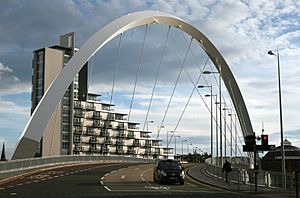Clyde Arc facts for kids
Quick facts for kids Squinty Bridge |
|
|---|---|

View of the Clyde Arc from the East
|
|
| Coordinates | 55°51′26″N 4°16′57″W / 55.85722°N 4.28250°W |
| Carries | Motor vehicles, cyclists and pedestrians |
| Crosses | River Clyde |
| Locale | Glasgow, Scotland |
| Official name | Clyde Arc |
| Characteristics | |
| Width | 22 m (72 ft) |
| Longest span | 96 m (315 ft) |
| History | |
| Construction cost | £20.3 million (Budget) |
| Opened | 18 September 2006 |
| Statistics | |
| Toll | Free |
The Clyde Arc is a special road bridge in Glasgow, Scotland. Many people know it as the Squinty Bridge because it crosses the River Clyde at an angle. This bridge connects the Finnieston area, near the Clyde Auditorium and SEC, with Pacific Quay and the Glasgow Science Centre in Govan.
The bridge has a cool curved shape, which makes it stand out. It was the first new traffic bridge built in Glasgow city centre since the Kingston Bridge opened way back in 1970. The bridge officially got its name, "Clyde Arc," when it opened on September 18, 2006. Before that, people called it the "Finnieston Bridge" or the "Squinty Bridge."
Contents
Building the Squinty Bridge
The Clyde Arc was designed by a company called Halcrow Group. It was built by Edmund Nuttall. Glasgow City Council worked with Scottish Enterprise and the Scottish Government to make this project happen.
Workers built parts of the bridge on land. Then, they put them together on a large floating platform in the river. The bridge's main parts were finished in April 2006. The whole project cost about £20.3 million. This amazing bridge was built to last for 120 years!
Bridge Measurements and Features
The main part of the bridge is 96 meters (315 feet) long. It also has two smaller sections, each 36.5 meters (120 feet) long. This makes the total length of the bridge 169 meters (554 feet). The design includes a strong steel arch that supports the roadway.
The bridge is high enough for boats to pass underneath. It is about 5.4 meters (18 feet) above the average water level.
Opening Day
The Clyde Arc officially opened on September 18, 2006. Glasgow City Council leader Steven Purcell did the honors. However, people actually got to walk across it two days earlier. This was part of Glasgow's "Doors Open" Weekend. It was a special chance for everyone to see the new bridge up close.
Connecting Communities
The bridge links Finnieston Street on the north side of the river to Govan Road on the south side. It has four lanes for traffic. Two lanes are for public transport, like buses. The other two are for cars and other private vehicles. There are also special paths for people walking and riding bikes.
The Clyde Arc was built to help connect different parts of Glasgow. It makes it easier to get to Pacific Quay and other areas that are being redeveloped. The bridge was even designed to handle a future light rail or tram system. It is an important part of Glasgow's plans for growth and improvement.
Bridge Support Problem
The Clyde Arc had to close for a while between January and June 2008. This happened because one of its support cables broke. Another cable also showed small cracks.
On January 14, 2008, a part of one of the bridge's 14 hangers snapped. These hangers are like strong cables that hold up the road deck. They transfer the weight of the road to the bridge's arch. The police quickly closed the bridge to keep everyone safe.
Engineers checked the bridge carefully. They found a small crack in a second support cable. Because of this, all the connectors on these cables needed to be replaced. This meant the bridge had to stay closed for about six months. Even river traffic below the bridge had to stop.
Workers installed temporary frames on top of the bridge's arch. These frames helped support the bridge's weight while the broken parts were fixed. They replaced the faulty connectors on each hanger.
The bridge finally reopened on June 28, 2008. At first, only two of its four lanes were open. All the original steel connectors were replaced with stronger, milled steel ones. When it reopened, Glasgow City Council expected about 6,500 vehicles to cross the bridge every day.
Images for kids




